How to use this Lookup Table
This table takes several seconds to load intially and to reappear after making filter selections.
This table allows you to search and filter for forb species with certain attributes. Most columns can be filtered using the second row of the table. Information is grouped into categories indicated and color coded according to graphic below.
Clicking on any row will bring up the entirety of data available for the species including a photo and distribution map of the species, descriptions for many of the yes/no columns, a link back to the complete species review, and more.
Empty cells indicate a lack of this information currently or as of the posting of the species' review.
| Species Image | Image credit | Common name | Plant family (Common) | Plant family (Scientific) | Genus | Species | More information | Recent scientific name change? | Alternate scientific name | Subtaxa? | Hybridization? | Degree of hybridization | Hybridizes within | Polyploid? | Life cycle | Longevity | Growth form | Growth habit | Max height at maturity (in) | Min height at maturity (in) | Max width at maturity (in) | Min width at maturity (in) | Stem leaves | Basal leaves | Leaf arrangement | Leaf persistence | Leaf type | Root system | Max root depth (in) | Max root spread (in) | Occurrence | Occurrence map | Map description | Major plant associations | Max elevation (ft) | Min elevation (ft) | Max precipitation (in) | Min precipitation (in) | Soil texture range | Predominant soil texture | Soil pH, salinity, sodicity | Description of soil pH, salinity, sodicity | Soil depth | Successional status | Disturbance tolerance | Light requirement | Inflorescence type | Flowers per inflorescence | Individual flower color | Flower type | Flower type details | Pollination type | Pollination agent | Animal pollinators | Fruit description | Plant flowering and fruit ripening pattern | Description of flowering and fruit ripening pattern | Dehiscence | Dispersal unit | Dispersal agent | Dispersal rate | Description of seed dispersal and rate | Flowering phenology (location dependent) | More than one flowering event possible in a single growing season (e.g. flowers in spring and again in fall)? | Date of fruit maturation (location dependent) | Structure collected | Maturation indicators | Seed color | Common seed predators | Characteristics of damaged, low quality fruit/seed | Uniformity of ripening | Description of fruit ripening (within and among plants) | Quick tests of seed fill/quality | Harvest window duration | Wildland harvest method(s) | Wildland harvest equipment | Post-harvest management | Special post-harvest management notes | General seed cleaning procedure | Seed cleaning protocol available? | Average clean-out ratio (clean/rough) | Clean-out ratio (min) | Clean-out ratio (max) | Clean-out ratio (number of samples) | Seed dormancy type | AOSA protocol for evaluating viability? | Time required to test viability | Viability protocol is for the: | AOSA test for germination? | Time required to test germination | Germination test is for the: | Average purity (%) | Purity (min %) | Purity (max %) | Purity sample size (n) | Average fill (%) | Fill (min %) | Fill (max %) | Fill sample size (n) | Average viability (%) | Viability (min %) | Viability (max %) | Viability sample size (n) | Average bulk seeds/lb | Bulk seeds/lb (min) | Bulk seeds/lb (max) | Bulk seeds/lb sample size (n) | Average pure live seeds (PLS)/lb | PLS (min) | PLS (max) | PLS sample size (n) | Seed type | Cold storage required? | Seed production research conducted? | Soil protective measures | Treatments to enhance germination (Seed Production) | Method (equipment) | Seeding date | Seeding depth (in) | Does fertilization increase seed yield? | Irrigation increase seed yield? | Managed pollinators effective? | Known agricultural pests/diseases? | Plant age (yr) at first harvest | Harvest date | Seed ripening pattern | Seed retention | Harvesting method/equipment | Stand life (yrs) | Treatments to enhance germination (Nursery) | Wildland protocols available | Treatments to enhance germination (Wildland Seeding) | Wildland Seeding Machinery | Seeding Date | Seeding Depth (in) | Seed mix | Planting seedlings used to | |||||||||
|---|---|---|---|---|---|---|---|---|---|---|---|---|---|---|---|---|---|---|---|---|---|---|---|---|---|---|---|---|---|---|---|---|---|---|---|---|---|---|---|---|---|---|---|---|---|---|---|---|---|---|---|---|---|---|---|---|---|---|---|---|---|---|---|---|---|---|---|---|---|---|---|---|---|---|---|---|---|---|---|---|---|---|---|---|---|---|---|---|---|---|---|---|---|---|---|---|---|---|---|---|---|---|---|---|---|---|---|---|---|---|---|---|---|---|---|---|---|---|---|---|---|---|---|---|---|---|---|---|---|---|---|---|---|---|---|---|---|---|---|---|---|---|---|---|---|---|
| Species Image | Image credit | Common name | Plant family (Common) | Plant family (Scientific) | Genus | Species | More information | Recent scientific name change? | Alternate scientific name | Subtaxa? | Hybridization? | Degree of hybridization | Hybridizes within | Polyploid? | Life cycle | Longevity | Longevity description | Growth form | Growth habit | Max height at maturity (in) | Min height at maturity (in) | Max width at maturity (in) | Min width at maturity (in) | Stem leaves | Basal leaves | Leaf arrangement | Leaf persistence | Leaf type | Root system | Max root depth (in) | Max root spread (in) | Occurrence | Occurrence map | Map description | Major plant associations | Max elevation (ft) | Min elevation (ft) | Max precipitation (in) | Min precipitation (in) | Soil texture range | Predominant soil texture | Soil pH, salinity, sodicity | Description of soil pH, salinity, sodicity | Soil depth | Soil description | Successional status | Disturbance tolerance | Disturbance tolerance description | Light requirement | Inflorescence type | Flowers per inflorescence | Individual flower color | Flower type | Flower type details | Pollination type | Pollination description | Pollination agent | Animal pollinators | Fruit description | Plant flowering and fruit ripening pattern | Description of flowering and fruit ripening pattern | Dehiscence | Dispersal unit | Dispersal agent | Dispersal rate | Description of seed dispersal and rate | Flowering phenology (location dependent) | More than one flowering event possible in a single growing season (e.g. flowers in spring and again in fall)? | Time from flowering to fruit maturation (days) | Date of fruit maturation (location dependent) | Structure collected | Maturation indicators | Seed color | Common seed predators | Characteristics of damaged, low quality fruit/seed | Uniformity of ripening | Description of fruit ripening (within and among plants) | Quick tests of seed fill/quality | Harvest window duration | Wildland harvest method(s) | Wildland harvest equipment | Wildland harvest rate | Post-harvest management | Special post-harvest management notes | General seed cleaning procedure | Seed cleaning protocol available? | Average clean-out ratio (clean/rough) | Clean-out ratio (min) | Clean-out ratio (max) | Clean-out ratio (number of samples) | Seed dormancy type | AOSA protocol for evaluating viability? | Time required to test viability | Viability protocol is for the: | AOSA test for germination? | Time required to test germination | Germination test is for the: | Average purity (%) | Purity (min %) | Purity (max %) | Purity sample size (n) | Average fill (%) | Fill (min %) | Fill (max %) | Fill sample size (n) | Average viability (%) | Viability (min %) | Viability (max %) | Viability sample size (n) | Average bulk seeds/lb | Bulk seeds/lb (min) | Bulk seeds/lb (max) | Bulk seeds/lb sample size (n) | Average pure live seeds (PLS)/lb | PLS (min) | PLS (max) | PLS sample size (n) | Seed type | Cold storage required? | Longevity (yrs) | Seed production research conducted? | Soil protective measures | Treatments to enhance germination (Seed Production) | Method (equipment) | Seeding date | Seeding rate with units | Seeding depth (in) | Does fertilization increase seed yield? | Irrigation increase seed yield? | Managed pollinators effective? | Known agricultural pests/diseases? | Plant age (yr) at first harvest | Harvest date | Seed ripening pattern | Seed retention | Harvesting method/equipment | Seed yield (average and range) | Stand life (yrs) | Treatments to enhance germination (Nursery) | Wildland protocols available | Treatments to enhance germination (Wildland Seeding) | Wildland Seeding Machinery | Seeding Date | Seeding Depth (in) | Seed mix | Planting seedlings used to |
 |
USDI BLM NM930N SOS. | Hoary tansyaster | Aster | Asteraceae | Dieteria | canescens | https://westernforbs.org/species/dieteria-machaeranthera-canescens-hoary-tansyaster/ | Yes | Machaeranthera canescens | Yes | Yes | Common | The species (infrataxa), The genus (other species) | No | Annual, Biennial, Perennial | Short-lived (1-3 yrs) | Longevity varies with the subspecies. The artistata and glabra varieties typically grow as annuals or biennials, variety nebraskana grows as a biennial or short-lived perennial, and variety ziegleri is a perennial subshrub. | Forb, Subshrub | Decumbent/prostrate/spreading, Erect/ascending | 40 | 2.5 | Yes | Yes | Alternate | Herbaceous perennial (dies back annually) | Simple | Tap | AZ, CA, CO, IA, ID, KS, MT, ND, NE, NM, NV, OR, SD, TX, UT, WA, WI, WY, AB, BC, SK, MX - BN, MX - CH, MX - SO | 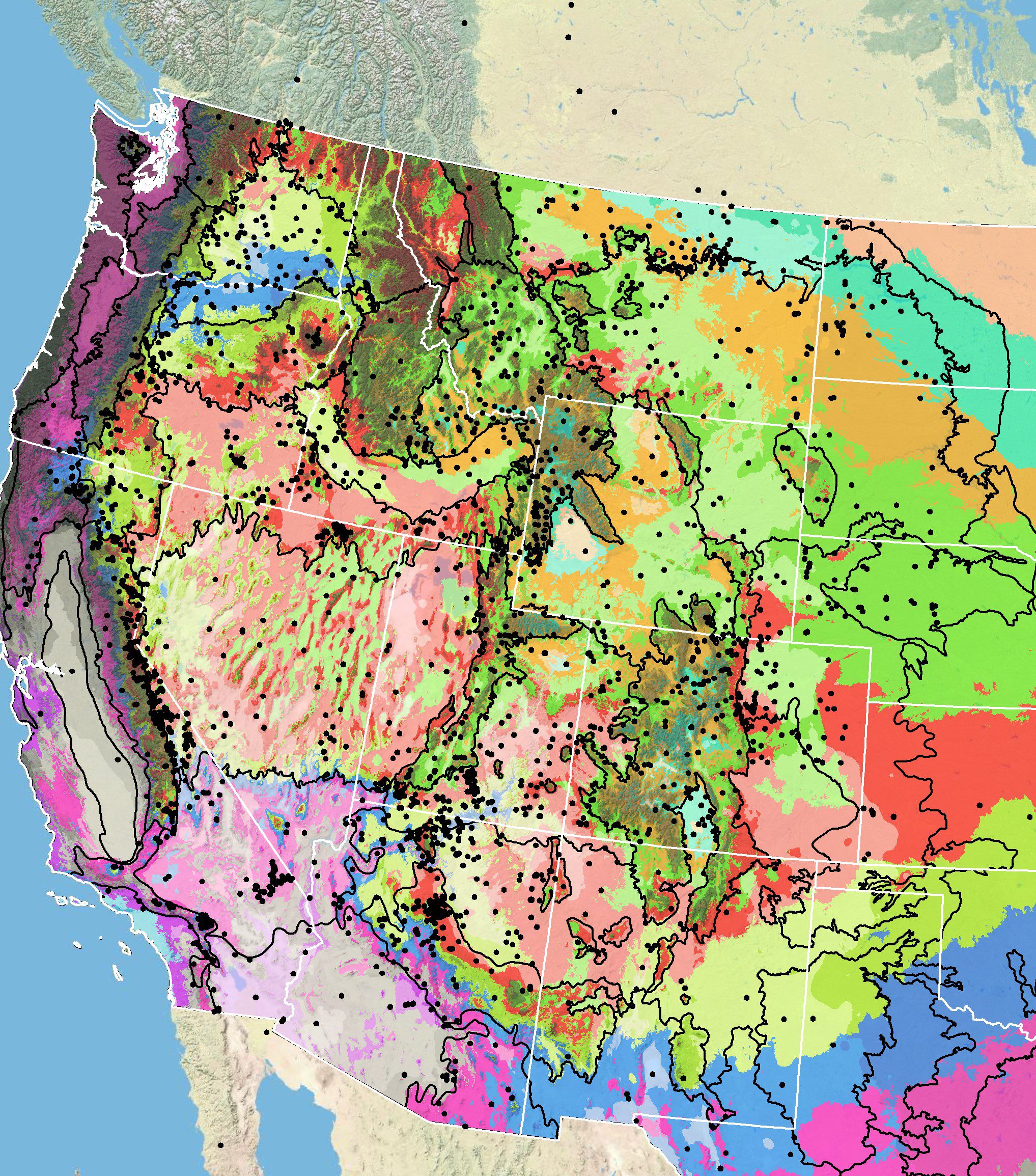 |
Distribution of hoary tansyaster (black circles) based on geo-referenced herbarium specimens and observational data from 1849-2016. Generalized provisional seed zones (colored regions) are overlain by Omernik Level III Ecoregions (black outlines). Map prepared by M. Fisk, USGS. | Semi-desert grasslands, Prairie, Low sage, Salt desert, Sagebrush, Warm desert, Mountain brush, Pinyon-Juniper, Aspen, Dry forest, Mesic forest | 11,000 | 0 | 60 | 8 | Sand, Loam, Coarse - Gravelly, rocky | Rocky, gravelly, Coarse | Neutral, Acidic, Alkaline | Tolerates pH range 6 to 8.4, but it is more common on alkaline soils. | Moderate | Hoary tansyaster grows well on medium- to coarse-textured soils with pH of 6 to 8.4 and rooting depths of at least 10 in (25 cm) (Tilley et al. 2014). It is common in loamy to sandy alkaline soils with gravel and rocks. | Pioneer, Early | Fire, Grazing, Soil disturbance | Hoary tansyaster is an early colonizer in both primary and secondary succession. It establishes readily from shattered seed. It is common on disturbed sites and its abundance and persistence may benefit from periodic disturbance. It is used by many wildlife species, but is little used by cattle. | Full sun | Head, Panicle, Raceme | 11-100 | Blue, Pink, Purple, White | Perfect, Female (pistillate) | Outcrossing | Biotic (animal) | Bees, Butterflies, Flies | Achene | Indeterminate | Timing of flowering varies among varieties and generally occurs over a long period. | Indehiscent | Fruit | Animals, Gravity, Wind | Rapid | Late spring, Early summer, Summer, Late summer, Early fall, Fall | No | Four to five weeks | June, July, August, September, October, November | Fruit | Dry fruit, Hard seed, Pappus expanded | brown | Aphids, Insects, Diseases (fungi), Rodents | Insects and damage visible, Low fill of seed/fruit, Mold or disease visible, Obvious predation, Seeds shriveled or malformed | Indeterminate | Variable | Cut test (individual seed or seedhead), X-ray | Narrow (<1 wk) | Plucking, Stripping, Swatting/beating | Containers, Dust masks, Gloves, Racquets | Dry thoroughly, Discard bulky vegetative material, Control for insects, Protect from rodents, Store in breathable containers, Protect from overheating | Seeds collected during cool or wet periods require careful and immediate drying. Vegetative material is sticky making careful drying necessary. | Break apart inflorescence to extract individual fruits or seeds, Remove seed appendages (i.e. pappus/ wings), Remove extra vegetative material (i.e. leaves, stems, etc.) | Yes | 0.15 | 0.00 | 0.83 | 121 | Not dormant | Yes | 2-3 days | Species | No | 91.00 | 30 | 99 | 121 | 91.00 | 68 | 99 | 122 | 89 | 49 | 99 | 94 | 1,116,176.00 | 252,000.00 | 2,180,769.00 | 121 | 921,408.00 | 405,784.00 | 1,949,184.00 | 94 | Orthodox | Unknown | Yes | Row cover, Weed fabric | Stratification (fall/winter seeding, artificial) | Drill, Hilling | Fall, Late fall | 0.35 to 2 lb/acre PLS or | <0.25 | No, Trial results provided | Yes | Yes | One | July, August, September, October | Indeterminate | Poor | Hand, Mechanical, Combine, Vacuum harvester, Swather | 200-400 lbs/acre bulk | 1-2 | Stratification (fall/winter seeding, artificial) | Yes | Stratification (fall/winter seeding, artificial) | Broadcast, Drill | Fall, Late fall | <0.25 | Add to overall seed mix if broadcast seeding and covering, Mix with other small-seeded species if drill seeding, Seed with other forbs in pre-selected patches | Establish forb patches, Replace time to seed production, Improve establishment, Improve return on small or expensive seed lots | ||||||||||||
 |
J. Cane, USDA ARS. | Douglas’ dustymaiden | Aster family | Asteraceae | Chaenactis | douglasii | https://westernforbs.org/species/douglas-dustymaiden-chaenactis-douglasii/ | No | Yes | Yes | Common | The species (infrataxa) | Yes | Annual, Biennial, Perennial | Short-lived (1-3 yrs) | Longevity varies among populations. Shorter lived plants are more common in dry areas. | Forb | Clumping/caespitose, Decumbent/prostrate/spreading, Erect/ascending | 36 | 2 | Yes | Yes | Alternate | Herbaceous perennial (dies back annually) | Simple | Tap | 15 | AZ, CA, CO, ID, MT, ND, NM, NV, OR, SD, UT, WA, WY, AB, BC, SK | 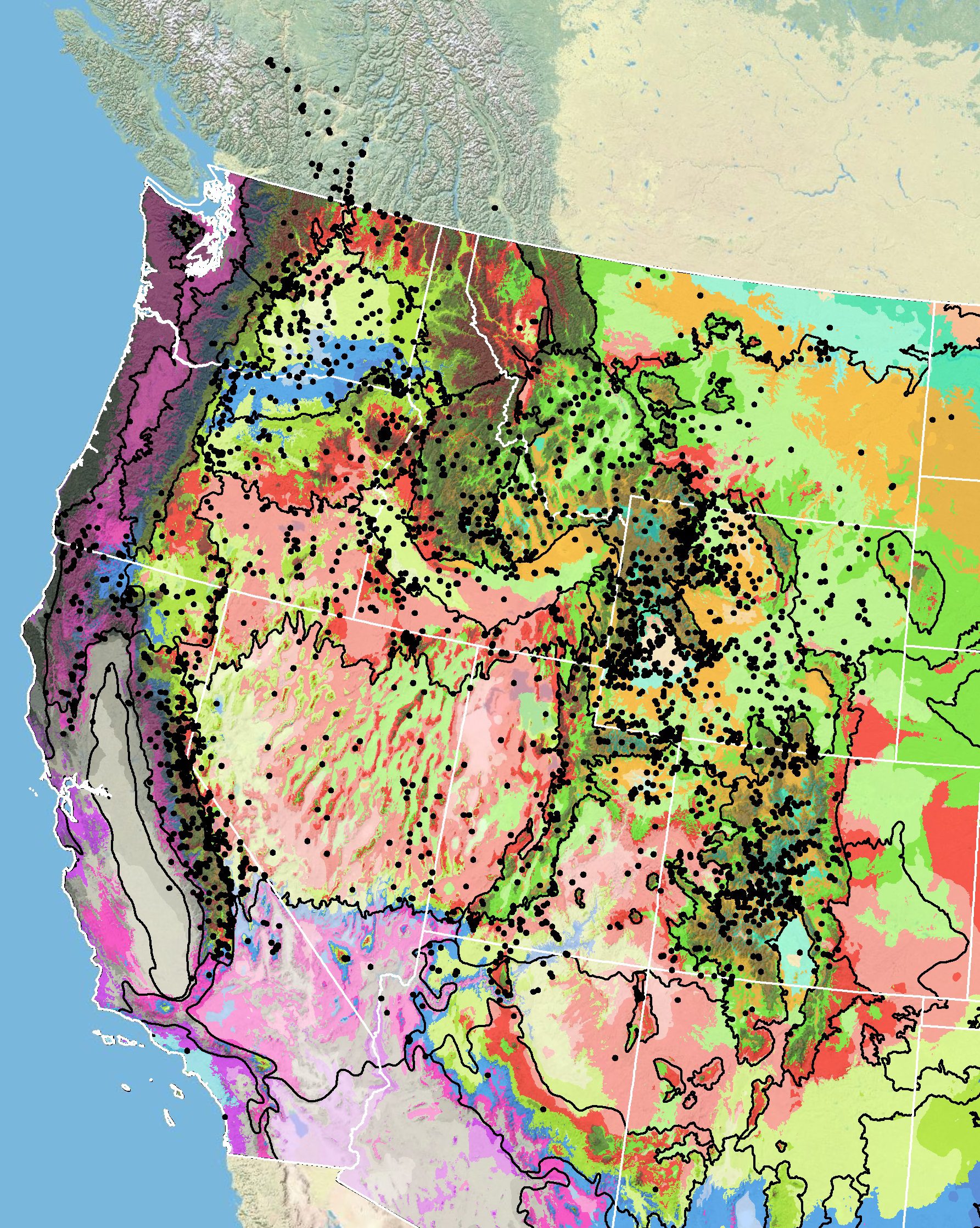 |
Distribution of Douglas’ dustymaiden (black circles) based on geo-referenced herbarium specimens and observational data from 1881-2016. Generalized provisional seed zones (colored regions) are overlain by Omernik Level III Ecoregions (black outlines). Map prepared by M. Fisk, USGS. | Semi-desert grasslands, Prairie, Salt desert, Sagebrush, Mountain brush, Pinyon-Juniper, Dry forest | 13,100 | 0 | 7 | Silt, Sand, Coarse - Gravelly, rocky | Rocky, gravelly, Coarse | Neutral, Acidic, Alkaline, Saline | Reported from saline (0.06 - 0.5 dS/m) and pH 4.2 to 7.9 soils, but also on basic soils. | Deep, Moderate, Shallow | Grows on a variety of substrates. | Pioneer, Early, Mid, Late (climax) | Fire, Soil disturbance | Full sun | Cyme, Head | 11-100 | Pink, White | Perfect | Heads may contain ray and disk flowers. Some heads may contain only ray or disk flowers. | Selfing, Outcrossing | Seed production is greatly improved by cross-pollination. | Biotic (animal) | Bees | Achene | Indeterminate | Indehiscent | Fruit | Gravity, Wind | Moderate | Ripening is highly variable within and among plants of a population. | Spring, Late spring, Early summer, Summer, Late summer | No | 28 - 35 | June, July, August, September, October | Fruit | Dry fruit, Hard seed, Pappus expanded | Gold to black | Insects and damage visible, Low fill of seed/fruit, Mold or disease visible, Obvious predation, Seeds shriveled or malformed | Indeterminate | Variable. | Cut test (individual seed or seedhead), Fingernail pressure test, X-ray, Other | Moderate (1-3 wks) | Clipping, Plucking, Stripping, Swatting/beating | Clippers, Containers, Dust masks, Gloves | 0.33 lbs/hr | Dry thoroughly, Discard bulky vegetative material, Control for insects, Protect from rodents, Store in breathable containers, Protect from overheating | Dry seed collections immediately, especially if collected in fall when moisture content may be high. | Break apart inflorescence to extract individual fruits or seeds, Remove seed appendages (i.e. pappus/ wings), Remove extra vegetative material (i.e. leaves, stems, etc.) | Yes | 0.19 | 0.02 | 0.70 | 101 | Physiological (needs stratification), Morphological (needs afterripening) | No | No | 96.00 | 78 | 98 | 100 | 93.00 | 70 | 99 | 101 | 92 | 79 | 99 | 67 | 374.72 | 210,780.00 | 620,000.00 | 101 | 326,999.00 | 208,802.00 | 565,440.00 | 67 | Orthodox | Yes | 5 yrs | Yes | Row cover, Weed fabric, Sawdust, Sand | Stratification (fall/winter seeding, artificial), Seed coating (fungicide, fertilizer, etc.) | Drill, Hilling | Fall, Late fall | 20 - 30 seeds/ft; 3 lbs PLS/acre; 12 - 25 seeds/hole (if weed fabric is used) | <0.25 | No | Yes | No | One | June, July | Indeterminate | Moderate | Hand, Mechanical, Combine, Vacuum harvester | 3-5 on a scale of 1-9, where1 indicates extremely high seed yield. | 1-2 | Stratification (fall/winter seeding, artificial), Seed coating (fungicide, fertilizer, etc.) | Yes | Stratification (fall/winter seeding, artificial) | Broadcast, Drill | Fall, Late fall | <0.25 | Add to overall seed mix if broadcast seeding and covering, Mix with other small-seeded species if drill seeding, Seed with other forbs in pre-selected patches | Establish forb patches, Replace time to seed production, Improve establishment, Improve return on small or expensive seed lots | |||||||||||||
 |
Photo: USDI BLM WY 050 SOS. | Arrowleaf balsamroot | Aster family | Asteraceae | Balsamorhiza | sagittata | https://westernforbs.org/species/arrowleaf-balsamroot-balsamorhiza-sagittata/ | No | No | Yes | Common | The genus (other species) | No | Perennial | Long-lived (4 or more yrs) | 40+ years | Forb | Clumping/caespitose, Erect/ascending | 30 | 36 | Yes | Herbaceous perennial (dies back annually) | Simple | Tap | 108 | 36 | AZ, CA, CO, ID, MT, ND, NV, OR, SD, UT, WY, AB, BC | 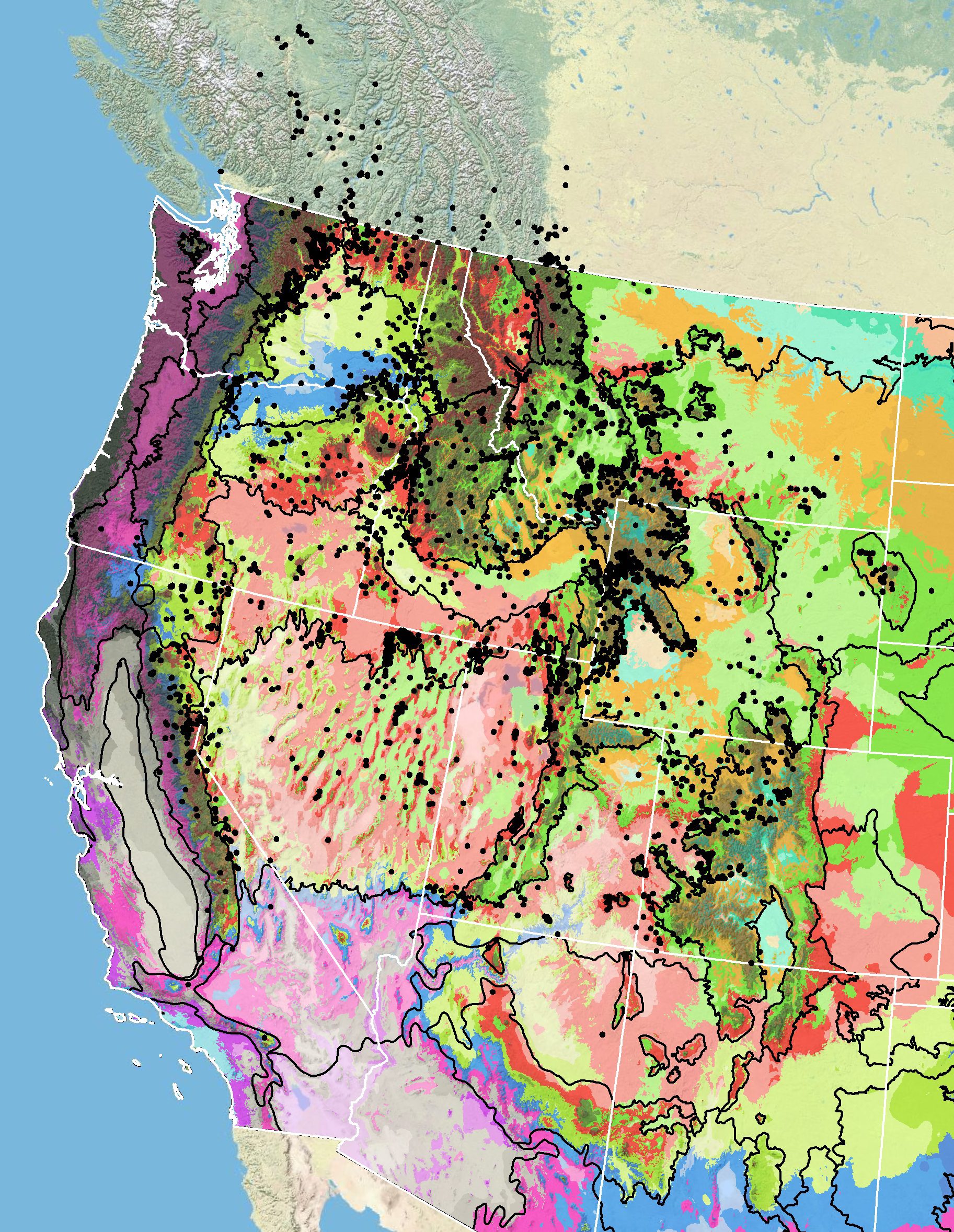 |
Distribution of arrowleaf balsamroot (black circles) based on geo-referenced herbarium specimens and observational data from 1870-2016. Generalized provisional seed zones (colored regions) are overlain by Omernik Level III Ecoregions (black outlines). Map prepared by M. Fisk, USGS. | Semi-desert grasslands, Low sage, Sagebrush, Mountain brush, Pinyon-Juniper, Aspen, Dry forest | 9,850 | 330 | 25 | 9 | Clay, Silt, Sand, Loam, Coarse - Gravelly, rocky | Coarse, Medium, Fine | Neutral | Plants tolerate soils that are weakly acidic to weakly basic (pH 6.5 to 8) and have low salinity. | Deep | Deep, well-drained, neutral, fine to coarse-textured soils. | Pioneer, Early, Mid, Late (climax) | Fire, Soil disturbance | Not an early colonizer if it was not present pre-disturbance. | Full sun | Head, Solitary | 11-100, >100 | Yellow | Perfect, Female (pistillate) | Ray flowers are female, disk flowers are perfect. | Selfing, Outcrossing | Seed production is improved with cross-pollination. | Biotic (animal) | Bees | Achene | Determinate | Flowering and fruit ripening are fairly uniform, but vary to some extent with and among seed heads. | Indehiscent | Fruit | Animals, Gravity | Slow | Early spring, Spring, Late spring, Early summer, Summer | No | 48-98 | May, June, July, August, September, October | Fruit, Infloresence | Dry fruit, Hard seed, Straw, brown colored stems | Gray to black | Insects, Rodents, Birds, Livestock, Native ungulates | Insects and damage visible, Low fill of seed/fruit, Obvious predation, Seeds shriveled or malformed | Determinate | Because dispersal is fairly slow, it is possible to delay harvesting until many seed heads are mature. | Cut test (individual seed or seedhead), Fingernail pressure test, X-ray | Moderate (1-3 wks) | Clipping, Plucking, Swatting/beating, Mechanical (extensive monocultures) | Clippers, Containers, Dust masks, Gloves, Hoppers, Paddles | 150 lbs by 2 or 3 people over 2 or 3 days | Dry thoroughly, Discard bulky vegetative material, Control for insects, Protect from rodents, Store in breathable containers, Protect from overheating | Store seed in a rodent-free area. | Break apart inflorescence to extract individual fruits or seeds, Remove extra vegetative material (i.e. leaves, stems, etc.) | Yes | 0.22 | 0.01 | 0.79 | 63 | Physiological (needs stratification), Morphological (needs afterripening) | Yes | 2-3 days | Genus | Yes | 84 days | Species | 98.00 | 89 | 99 | 63 | 85.00 | 45 | 97 | 63 | 94 | 79 | 98 | 50 | 49,608.00 | 23,000.00 | 80,710.00 | 63 | 44,696.00 | 21,404.00 | 63,160.00 | 50 | Orthodox | Yes | 5-7 yrs. cold storage is recommended | Yes | Row cover, Sawdust | Stratification (fall/winter seeding, artificial), Afterripening | Drill, Hilling | Fall, Late fall | 20 PLS/linear ft or 4-5 PLS/hill | 0.5-1 | Variable | Yes | Yes | Three, Four, Five | May, June, July | Uniform | Moderate | Hand, Mechanical, Combine, Vacuum harvester | 75-125 lbs/acre at 90% purity | >3 | Stratification (fall/winter seeding, artificial), Afterripening | Yes | Stratification (fall/winter seeding, artificial), Afterripening | Drill | Fall, Late fall | 0.5-1, >1 | Add to overall seed mix if broadcast seeding and covering, Seed with other forbs in pre-selected patches | Establish forb patches, Replace time to seed production, Improve establishment, Improve return on small or expensive seed lots | |||||||
 |
M. Lavin, Montana State University. | Sagebrush false dandelion | Aster family | Asteraceae | Nothocalais | troximoides | https://westernforbs.org/species/nothocalais-troximoides-sagebrush-false-dandelion/ | No | Yes | Rare | The genus (other species) | No | Perennial | Unknown | Forb | Decumbent/prostrate/spreading, Erect/ascending | 18 | 2 | 24 | 4 | No | Yes | Herbaceous perennial (dies back annually) | Simple | Tap | CA, ID, MT, NV, OR, UT, WA, WY, BC | 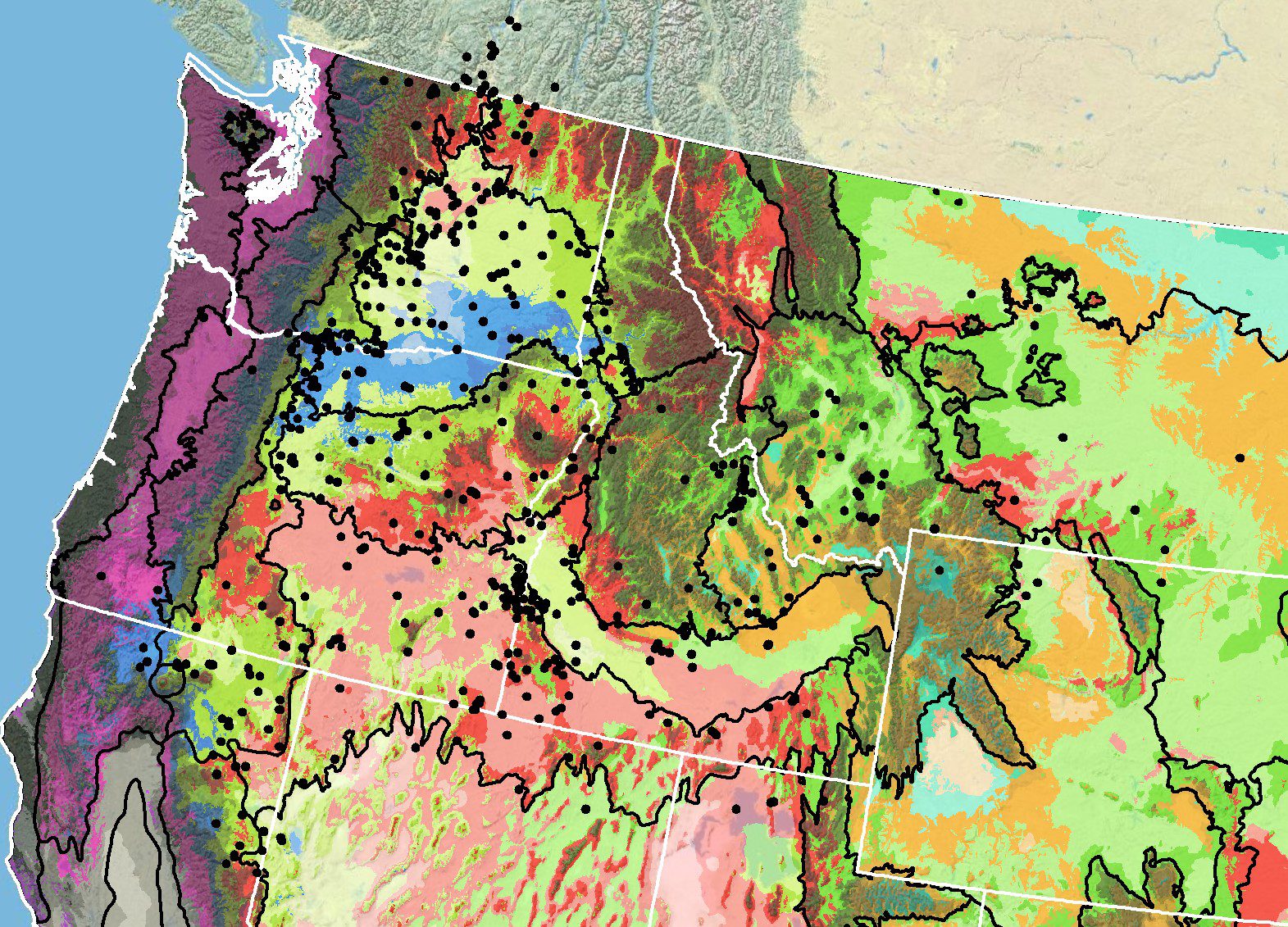 |
Distribution of sagebrush false dandelion (black circles) based on geo-referenced herbarium specimens and observational data from 1876-2016 (dates not available for all points). Generalized provisional seed zones (colored regions) are overlain by Omernik Level III Ecoregions (black outlines). Map prepared by M. Fisk, USGS. | Semi-desert grasslands, Sagebrush, Pinyon-Juniper, Oak woodlands, Dry forest | 8,763 | 160 | Clay, Silt, Sand, Loam, Coarse - Gravelly, rocky | Rocky, gravelly, Medium | Neutral, Alkaline | Deep, Moderate, Shallow | Often grows on shallow, rocky soils derived from basalt or rhyolite with soils that may be saturated in winter and spring and subject to frost heaving. | Pioneer, Early, Mid, Late (climax) | Fire, Soil disturbance | Plants may tolerate fall burns but be sensitive to spring burning. Roots are used by pocket gophers. Seeds are used by sage-grouse. |
Full sun | Head | 11-100 | Orange, Yellow | Perfect | Pollination of the species has not been studied. | Achene | Indeterminate | Flowering and fruit ripening are fairly uniform within seed heads, but vary among seed heads within individual plants and among plants in a population. | Indehiscent | Fruit | Animals, Gravity, Wind | Moderate | Dispersal rate varies with local wind speeds. | Early spring, Spring, Late spring, Early summer | No | About 2 months. | May, June, July | Fruit | Dry fruit, Hard seed, Pappus expanded, Straw, brown colored stems | Beige to light brown | Weevils, Birds | Insects and damage visible, Low fill of seed/fruit, Mold or disease visible, Obvious predation, Seeds shriveled or malformed | Indeterminate | Ripening is variable within and among plants., but uniform within seed heads. | Cut test (individual seed or seedhead), Fingernail pressure test, X-ray | Moderate (1-3 wks) | Plucking | Containers, Dust masks, Gloves | Dry thoroughly, Discard bulky vegetative material, Control for insects, Protect from rodents, Store in breathable containers, Protect from overheating | Remove vegetative material, which contains milky juice, and dry the seeds promptly to avoid molding. | Break apart inflorescence to extract individual fruits or seeds, Remove seed appendages (i.e. pappus/ wings), Remove extra vegetative material (i.e. leaves, stems, etc.) | No | 0.36 | 0.13 | 0.64 | 51 | Not dormant | No | No | 98.00 | 92 | 99 | 51 | 90.00 | 70 | 99 | 51 | 93 | 88 | 97 | 16 | 166,524.00 | 77,538.00 | 396,572.00 | 51 | 162,056.00 | 71,538.00 | 396,572.00 | 16 | Orthodox | Unknown | No | Yes | 150 lbs/acre | No | |||||||||||||||||||||||||||||||||||||||||
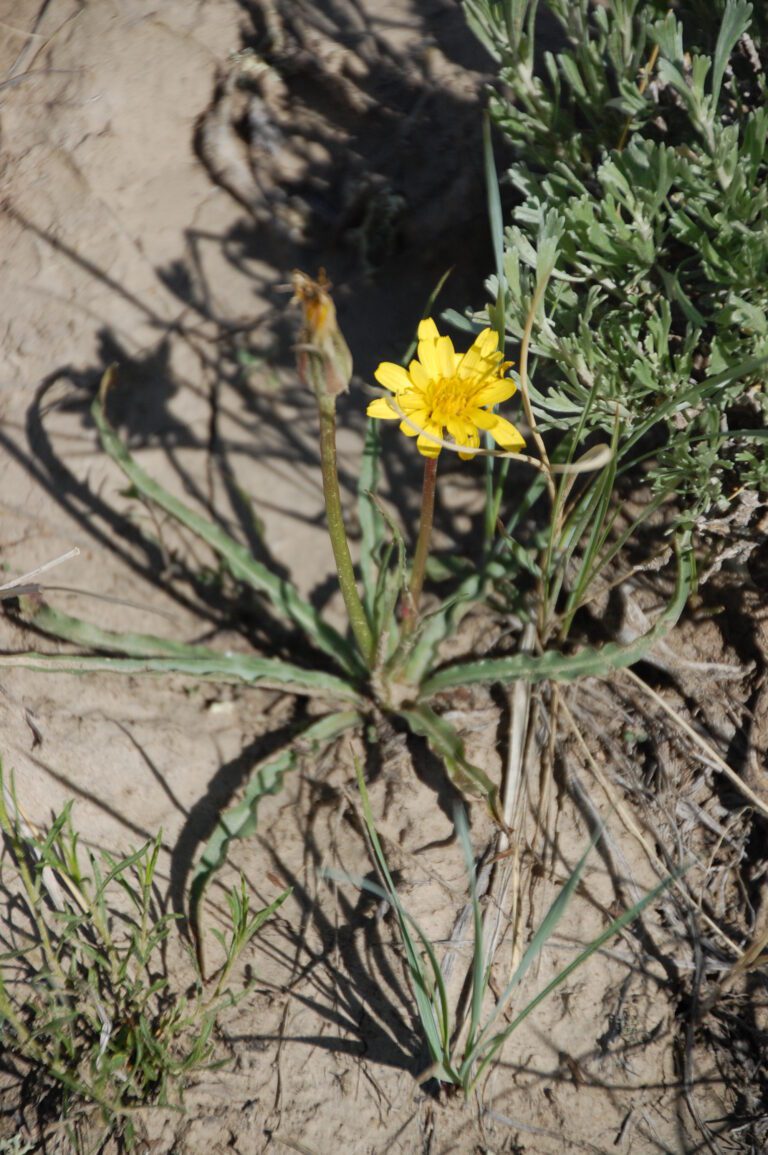 |
USDI BLM WY020 SOS. | Pale agoseris | Aster family | Asteraceae | Agoseris | glauca | https://westernforbs.org/species/pale-agoseris-agoseris-glauca/ | Yes | Yes | None | Yes | Perennial | Short-lived (1-3 yrs) | Forb | Erect/ascending | 24 | 24 | 2 | No | Yes | Alternate | Herbaceous perennial (dies back annually) | Simple | Tap | 24 | AK, AZ, CA, CO, IA, ID, KS, MI, MN, MT, ND, NE, NM, NV, OR, SD, UT, WA, WY, AB, BC, MB, NT, ON, SK | 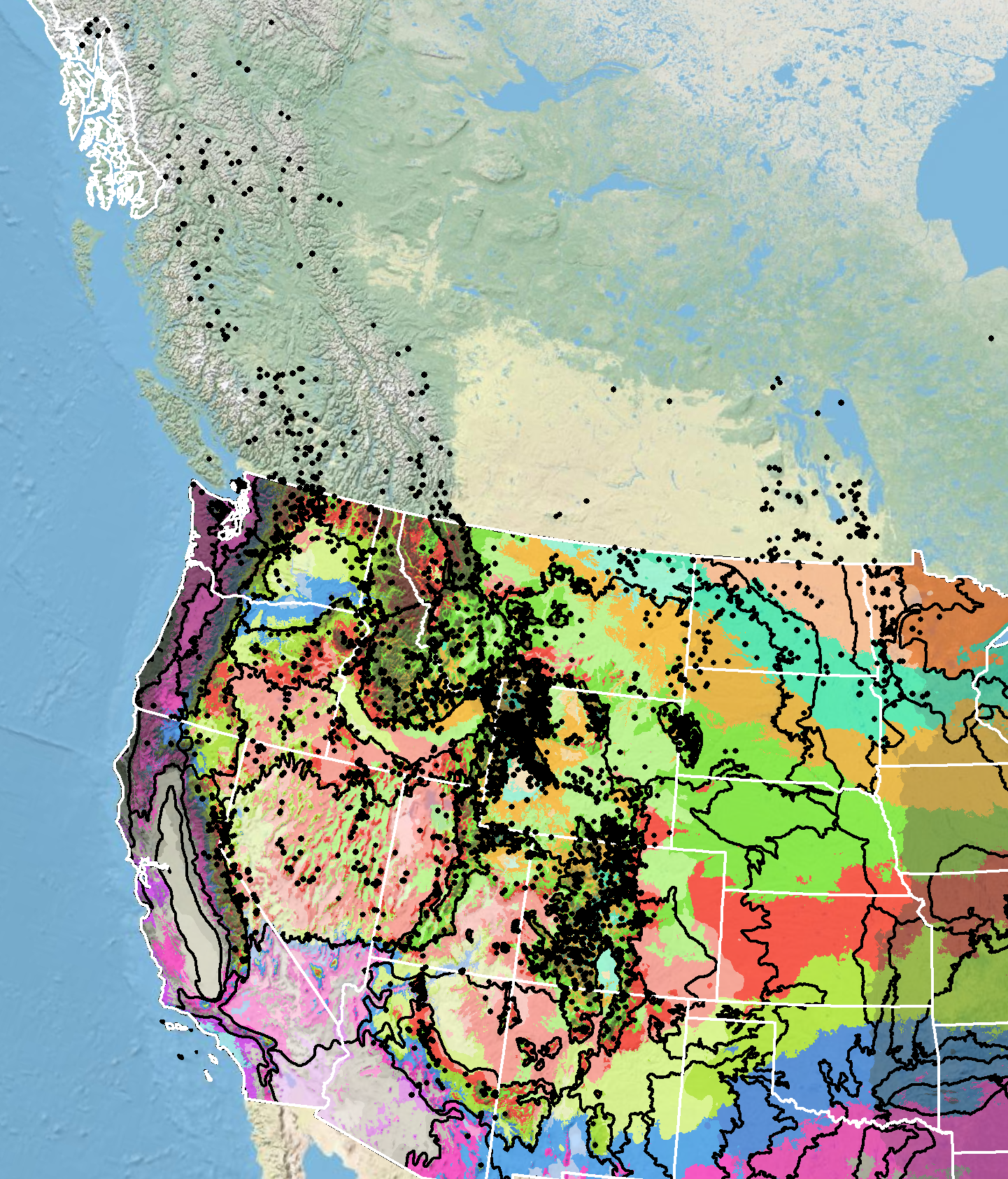 |
Distribution of pale agoseris (black circles) based on geo-referenced herbarium specimens and observational data from 1881–2016. Generalized provisional seed zones (colored regions) are overlain by Omernik Level III Ecoregions (black outlines). Map prepared by M. Fisk, USDI USGS. | Semi-desert grasslands, Prairie, Sagebrush, Riparian, Mountain brush, Pinyon-Juniper, Oak woodlands, Aspen, Dry forest, Mesic forest | 12,500 | 399 | 5 | Clay, Silt, Sand, Loam, Coarse - Gravelly, rocky | Rocky, gravelly, Coarse | Alkaline, Saline | Tolerates slightly alkaline or saline soils. | Deep, Moderate, Shallow | Pale agoseris is considered very adaptable, growing in many variations of soils and moisture conditions | Pioneer, Early, Mid, Late (climax) | Fire, Soil disturbance | Plant abundance tends to decrease with sheep grazing and increase with cattle grazing | Full sun | Head | 11-100, >100 | Yellow | Perfect | Outcrossing | Biotic (animal) | Bees, Butterflies, Flies, Wasps | Achene | Determinate | Indehiscent | Fruit | Wind | Rapid | Spring, Late spring, Early summer, Summer, Late summer | No | May, June, July, August, September | Fruit, Infloresence | Dry fruit, Hard seed, Pappus expanded | Golden brown | Insects, Diseases (fungi) | Insects and damage visible, Low fill of seed/fruit, Mold or disease visible, Obvious predation, Seeds shriveled or malformed | Determinate | Cut test (individual seed or seedhead), X-ray | Moderate (1-3 wks) | Plucking, Swatting/beating | Clippers, Containers, Gloves, Hoppers, Paddles, Racquets | Dry thoroughly, Discard bulky vegetative material, Control for insects, Protect from rodents, Store in breathable containers, Protect from overheating | Ripening heads commonly contain developing insects so control is necessary. Herbage contains milky juice so thorough drying is necessary to prevent molding. | Break apart inflorescence to extract individual fruits or seeds, Remove seed appendages (i.e. pappus/ wings), Remove extra vegetative material (i.e. leaves, stems, etc.) | Yes | 0.19 | 0.02 | 0.62 | 32 | Physiological (needs stratification), Not dormant | Yes | 1-2 days (test is for the Asteraceae) | No | 96.00 | 90 | 99 | 32 | 92.00 | 62 | 99 | 32 | 92 | 85 | 97 | 12 | 195,767.00 | 96,300.00 | 266,800.00 | 32 | 160,511.00 | 92,477.00 | 209,328.00 | 12 | Orthodox | No | Stratification (fall/winter seeding, artificial) | Drill | Fall, Late fall | Yes | Yes | May, June, July, August, September | Determinate | Poor | Stratification (fall/winter seeding, artificial) | No | Stratification (fall/winter seeding, artificial) | Broadcast, Drill | Fall, Late fall | 0.25-0.5, 0.5-1 | Add to overall seed mix if broadcast seeding and covering, Mix with other small-seeded species if drill seeding, Seed with other forbs in pre-selected patches | Establish forb patches, Replace time to seed production, Improve establishment, Improve return on small or expensive seed lots | ||||||||||||||||||||||||||||
 |
Showy goldeneye | Aster family | Asteraceae | Heliomeris | multiflora | https://westernforbs.org/species/showy-goldeneye-heliomeris-multiflora/ | No | Yes | No | None | Yes | Perennial | Long-lived (4 or more yrs) | up to 7 yrs | Forb, Subshrub | Erect/ascending | 51 | Yes | No | Alternate, Opposite | Herbaceous perennial (dies back annually) | Simple | Tap and fibrous | AZ, CA, CO, ID, MT, NM, NV, OR, SD, TX, UT, WY, MX - BN, MX - SO | 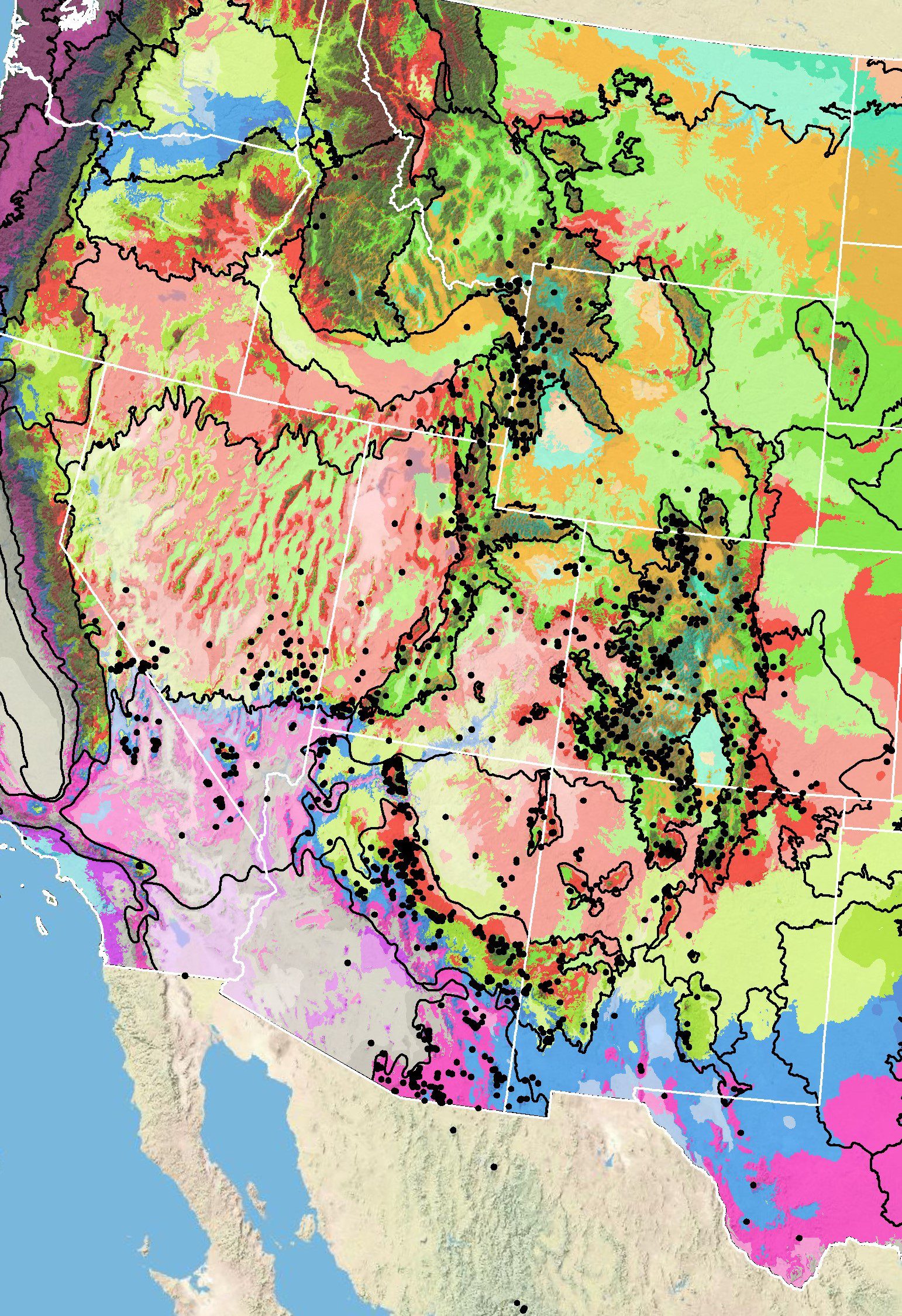 |
Distribution of showy goldeneye (black circles) based on geo-referenced herbarium specimens and observational data from 1895-2016. Generalized provisional seed zones (colored regions) are overlain by Omernik Level III Ecoregions (black outlines). Map prepared by M. Fisk, USGS. | Semi-desert grasslands, Prairie, Sagebrush, Riparian, Mountain brush, Pinyon-Juniper, Aspen, Dry forest | 11,800 | 3,000 | 26 | 18 | Clay, Silt, Sand, Coarse - Gravelly, rocky | Rocky, gravelly | Neutral, Acidic, Alkaline | pH of 6.1 to 7.8 reported. | Deep, Moderate, Shallow | Pioneer, Early, Mid, Late (climax) | Fire | Positive with respect to fire but unpredictable with grazing. | Full sun, Partial sun, Shade | Head | 11-100, >100 | Yellow | Perfect | Ray flowers are sterile, disk flowers are perfect and fertile. | Outcrossing | Biotic (animal) | Bees | Achene | Indeterminate | Indehiscent | Fruit | Animals, Gravity | Moderate | Late spring, Early summer, Summer, Late summer, Early fall, Fall | No | >55 | May, June, July, August, September, October, November | Fruit, Infloresence | Dry fruit, Hard seed | Brown to black | Insects, Rodents, Birds | Indeterminate | Cut test (individual seed or seedhead), Fingernail pressure test, X-ray | Moderate (1-3 wks) | Clipping, Stripping, Swatting/beating | Containers, Gloves | 0.01 - 0.7 lbs uncleaned seed/ person/ hr | Dry thoroughly, Discard bulky vegetative material, Control for insects, Protect from rodents, Store in breathable containers, Protect from overheating | Break apart inflorescence to extract individual fruits or seeds, Remove extra vegetative material (i.e. leaves, stems, etc.) | Yes | 0.18 | 0.02 | 0.85 | 54 | Physiological (needs stratification), Morphological (needs afterripening) | No | Yes | 56+ days | 96.00 | 68 | 99 | 55 | 93.00 | 82 | 99 | 55 | 95 | 78 | 98 | 47 | 873,610.00 | 477,473.00 | 1,553,424.00 | 55 | 776,093.00 | 458,565.00 | 1,300,713.00 | 47 | Orthodox | No | 2-7 yrs | Yes | Row cover, Weed fabric, Sawdust, Sand | Stratification (fall/winter seeding, artificial), Afterripening, Chemical | Drill | Fall, Late fall | 20 - 40 PLS/ft | <0.25 | Yes | Yes | Yes | One, Two | July, August | Indeterminate | Good | Hand, Combine | 122.37 (28.7 - 271.7) lbs/acre | >3 | No | Stratification (fall/winter seeding, artificial) | Fall, Late fall | <0.25, 0.25-0.5 | Add to overall seed mix if broadcast seeding and covering, Mix with other small-seeded species if drill seeding, Seed with other forbs in pre-selected patches | Establish forb patches, Replace time to seed production, Improve establishment, Improve return on small or expensive seed lots | |||||||||||||||||||||
 |
USFS | Aspen fleabane | Aster family | Asteraceae | Erigeron | speciosus | https://westernforbs.org/species/aspen-fleabane-erigeron-speciosus/ | No | No | Yes | Common | The genus (other species) | Yes | Perennial | Long-lived (4 or more yrs) | Decades | Forb | Erect/ascending, Rhizomatous | 40 | 6 | Yes | Yes | Alternate | Herbaceous perennial (dies back annually) | Simple | Tap and fibrous | AZ, CO, ID, KS, MT, NM, NV, OR, SD, TX, UT, WA, WY, AB, BC, MX - BN, MX - SO | 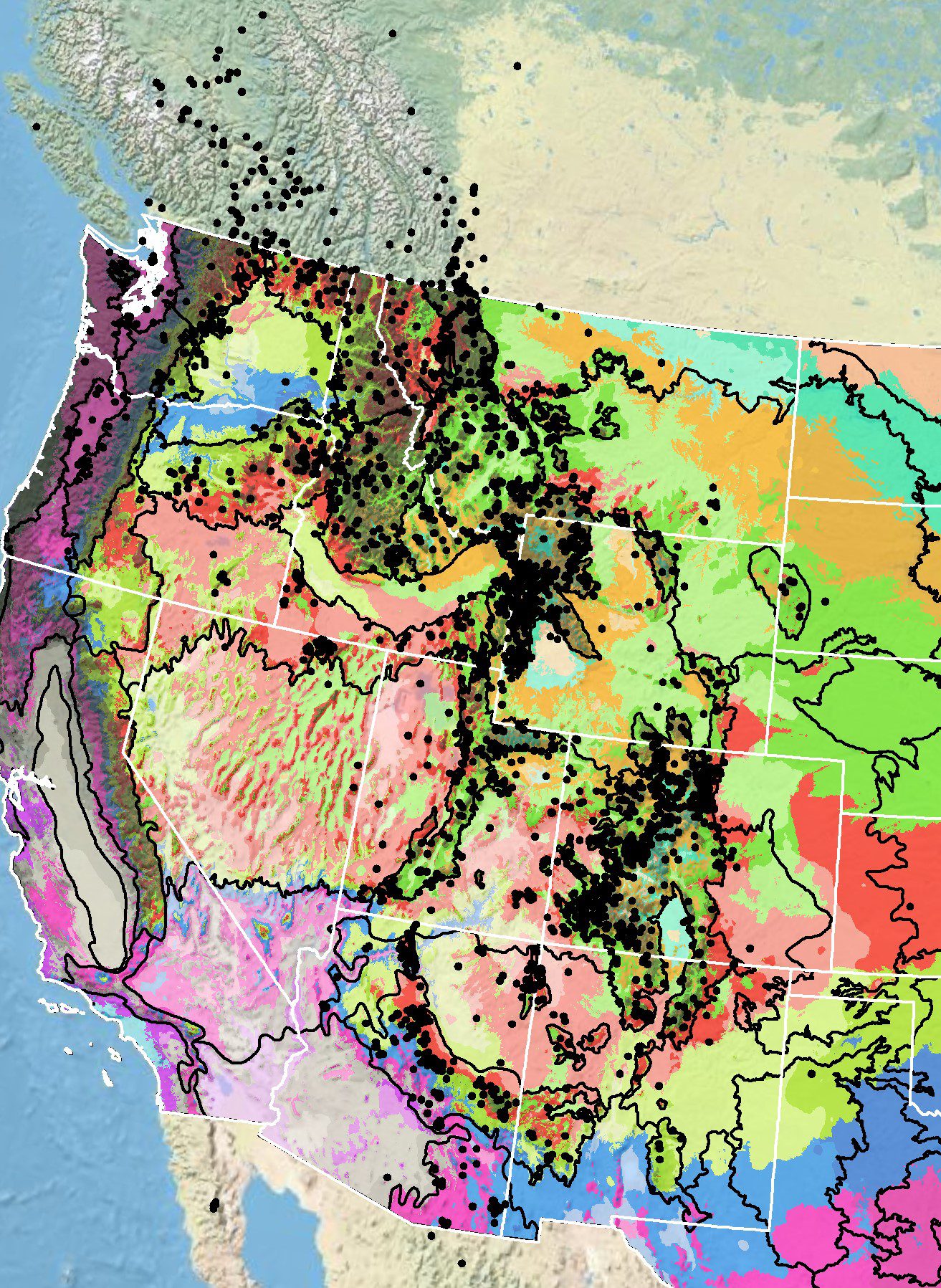 |
Distribution of aspen fleabane (black circles) based on geo-referenced herbarium specimens and observational data from 1870-2016. Generalized provisional seed zones (colored regions) are overlain by Omernik Level III Ecoregions (black outlines). Map prepared by M. Fisk, USGS. | Semi-desert grasslands, Prairie, Sagebrush, Riparian, Mountain brush, Aspen, Dry forest, Mesic forest, Subalpine, alpine | 11,200 | 2,000 | 25 | 16 | Clay, Silt, Sand, Loam, Coarse - Gravelly, rocky | Coarse | Neutral, Alkaline | Aspen fleabane is found on dry to moist sites with well-drained sandy, gravelly, or clay-loam calcareous or non-calcareous soils | Deep, Moderate | Pioneer, Early, Mid, Late (climax) | Fire | Often reduced by grazing | Full sun, Partial sun | Head | 11-100, >100 | Blue, Pink, Purple, White | Perfect, Female (pistillate) | Disk flowers are perfect and fertile. Ray flowers are pistillate and fertile. |
Outcrossing | Support generalist and specialist bee species. | Biotic (animal) | Bees, Beetles, Butterflies, Flies, Moths, Wasps | Achene | Determinate and indeterminate | Seed heads at the top of the plant may mature before those lower on the plant. Seeds within a seed head flower somewhat uniformly. Maturation may vary among plants in a population. | Indehiscent | Fruit | Gravity, Wind | Slow | Early summer, Summer, Late summer, Early fall, Fall | No | 30 - 60 | July, August, September, October, November | Fruit, Infloresence | Dry fruit, Hard seed, Pappus expanded | Straw, golden | Insects | Insects and damage visible, Low fill of seed/fruit | Determinate, Indeterminate | Rather uniform within the seed head. Varies among seed heads within a plant and among plants in a population. | Cut test (individual seed or seedhead) | Long (>3 wks) | Clipping, Plucking | Clippers, Containers, Gloves | Dry thoroughly, Discard bulky vegetative material, Control for insects, Protect from rodents, Store in breathable containers, Protect from overheating | Break apart inflorescence to extract individual fruits or seeds, Remove seed appendages (i.e. pappus/ wings), Remove extra vegetative material (i.e. leaves, stems, etc.) | Yes | 0.14 | 0.03 | 0.32 | 23 | Physiological (needs stratification), Not dormant | Yes | Family | Yes | 16+ days | Species | 95.00 | 75 | 99 | 23 | 94.00 | 80 | 99 | 23 | 94 | 79 | 98 | 17 | 2,451,669.00 | 1,064,788.00 | 3,600,000.00 | 23 | 2,249,218.00 | 1,439,775.00 | 3,080,160.00 | 17 | Yes | many | Yes | Drill | Fall | No | Yes | One | Good | >3 | Yes | Drill | Fall | <0.25, 0.25-0.5 | Add to overall seed mix if broadcast seeding and covering, Mix with other small-seeded species if drill seeding, Seed with other forbs in pre-selected patches | Establish forb patches, Replace time to seed production, Improve establishment, Improve return on small or expensive seed lots | |||||||||||||||||||||||
 |
BLM OR030, SOS. | Shaggy fleabane | Aster family | Asteraceae | Erigeron | pumilus | https://westernforbs.org/species/shaggy-fleabane-erigeron-pumilus/ | No | Yes | No | None | Yes | Perennial | Short-lived (1-3 yrs), Long-lived (4 or more yrs) | Forb | Clumping/caespitose, Erect/ascending | 20 | 2 | Yes | Yes | Alternate | Herbaceous perennial (dies back annually) | Simple | Tap | AZ, CA, CO, ID, KS, MT, ND, NE, NM, NV, OR, SD, UT, WA, WV, AB, BC, MB, SK |  |
Distribution of shaggy fleabane (black circles) based on geo-referenced herbarium specimens and observational data from 1881-2016. Generalized provisional seed zones (colored regions) are overlain by Omernik Level III Ecoregions (black outlines). Map prepared by M. Fisk, USDI USGS. | Semi-desert grasslands, Prairie, Sagebrush, Mountain brush, Pinyon-Juniper, Dry forest | 9,700 | 2,690 | 20 | 8 | Clay, Silt, Sand, Loam, Coarse - Gravelly, rocky | Rocky, gravelly, Coarse | Neutral, Alkaline | Deep, Moderate, Shallow | Early, Mid, Late (climax) | Fire | May not be flood tolerant; literature is mixed on burn-tolerance. Tolerates cattle grazing, but reduced by sheep use. | Head | >100 | Pink, Purple, White | Perfect, Female (pistillate) | Outcrossing | Biotic (animal) | Bees, Butterflies | Achene | Indeterminate | Indehiscent | Fruit | Animals, Wind | Moderate | Spring, Late spring, Early summer, Summer, Late summer, Early fall, Fall | Yes | 30 - 60 | May, June, July, August, September, October, November | Fruit | Dry fruit, Hard seed, Pappus expanded | Achene is light brown | Insects | Insects and damage visible, Low fill of seed/fruit, Seeds shriveled or malformed | Indeterminate | Cut test (individual seed or seedhead), Fingernail pressure test, X-ray | Moderate (1-3 wks) | Clipping, Plucking, Stripping, Swatting/beating | Clippers, Containers, Gloves | Dry thoroughly, Discard bulky vegetative material, Control for insects, Protect from rodents, Store in breathable containers, Protect from overheating | Break apart inflorescence to extract individual fruits or seeds, Remove seed appendages (i.e. pappus/ wings), Remove extra vegetative material (i.e. leaves, stems, etc.) | Yes | 0.13 | 0.02 | 0.27 | 37 | Physiological (needs stratification), Morphological (needs afterripening) | Yes | 12 - 56 hrs | Yes | 16+ days | 88.00 | 40 | 99 | 37 | 95.00 | 80 | 99 | 37 | 88 | 52 | 97 | 27 | 5,014,110.00 | 2,362,500.00 | 13,341,176.00 | 37 | 3,952,142.00 | 6,369,671.00 | 1,988,412.00 | 27 | Orthodox | Unknown | No | Stratification (fall/winter seeding, artificial) | <0.25 | Yes | Stratification (fall/winter seeding, artificial) | Yes | Fall, Late fall | <0.25 | Add to overall seed mix if broadcast seeding and covering, Mix with other small-seeded species if drill seeding, Seed with other forbs in pre-selected patches, Add to overall seed mix if drill seeding | Establish forb patches | ||||||||||||||||||||||||||||||||||||
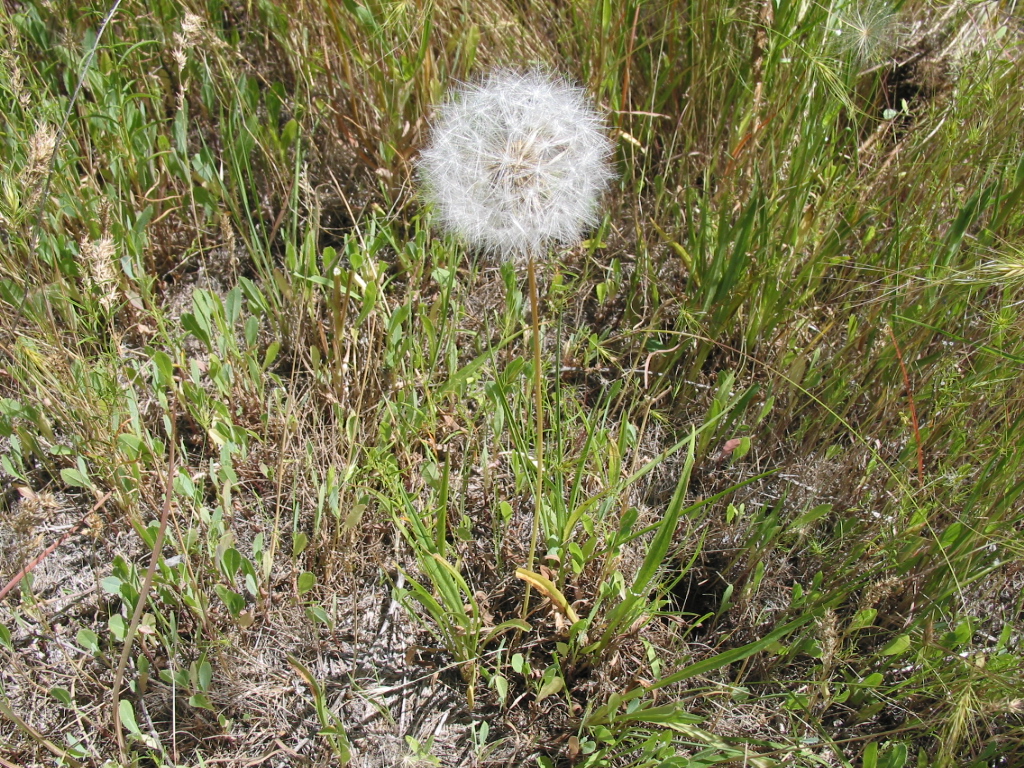 |
USDI BLM ID931 SOS. | Bigflower agoseris | Aster family | Asteraceae | Agoseris | grandiflora | https://westernforbs.org/species/bigflower-agoseris-agoseris-grandiflora/ | Yes | Yes | Rare | The genus (other species) | No | Perennial | Short-lived (1-3 yrs) | Bigflower agoseris is a short-lived, colonizing species | Forb | Erect/ascending | 33 | 32 | 8 | No | Yes | Herbaceous perennial (dies back annually) | Simple | Tap | CA, ID, MT, NV, OR, WA, BC | 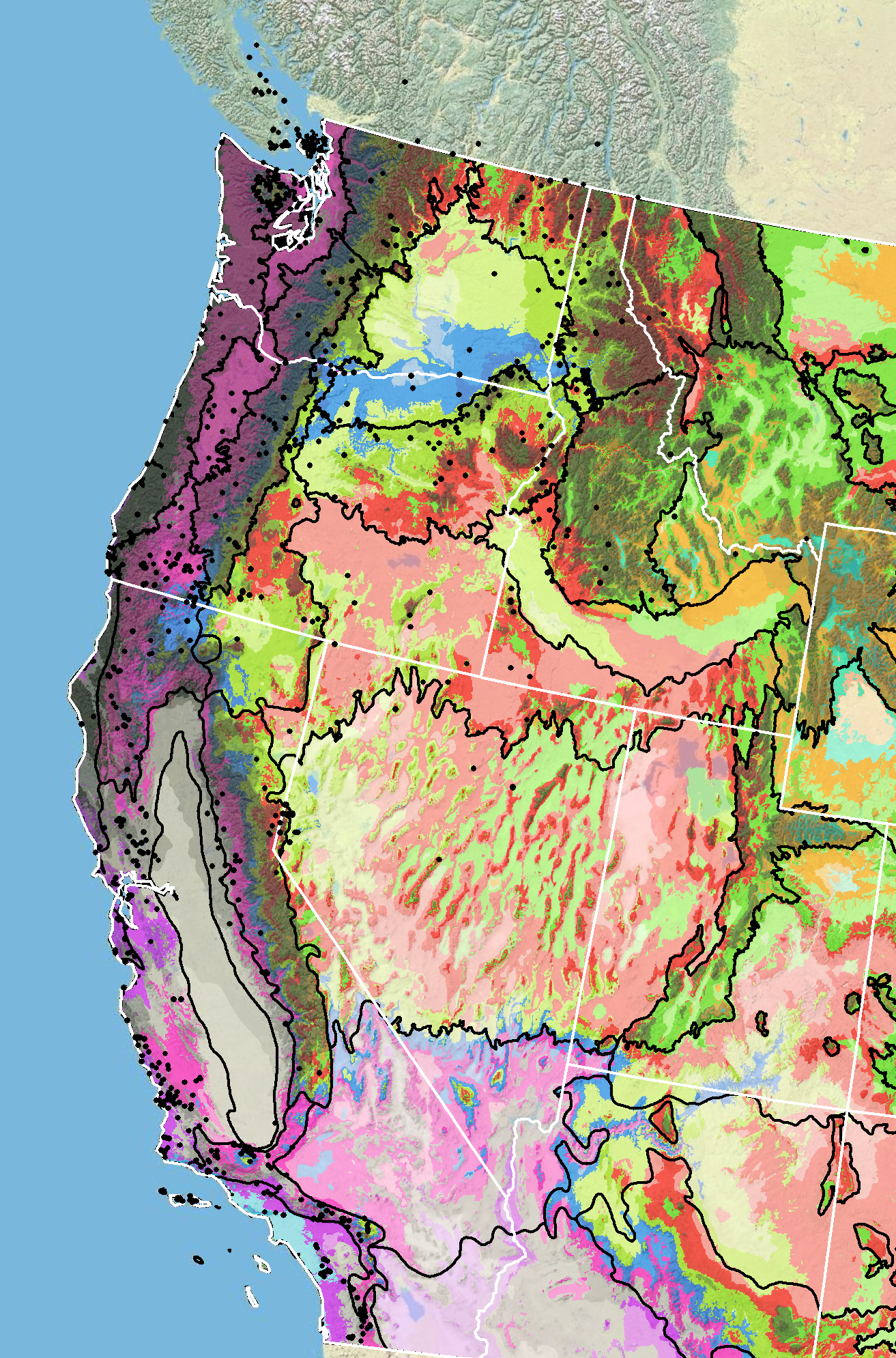 |
Distribution of bigflower agoseris (black circles) based on geo-referenced herbarium specimens and observational data from 1880–2023. Generalized provisional seed zones (colored regions) are overlain by Omernik Level III Ecoregions (black outlines). Map prepared by M. Fisk, USDI USGS. | Semi-desert grasslands, Sagebrush, Chaparral, Pinyon-Juniper, Dry forest | 8,200 | 30 | 29 | 12 | Clay, Coarse - Gravelly, rocky | Rocky, gravelly, Fine | Neutral | Deep, Moderate, Shallow | Bigflower agoseris tolerates a broad range of soil types | Pioneer, Early | Fire, Grazing, Soil disturbance | Full sun | Head | 11-100, >100 | Yellow | Perfect | Outcrossing | Biotic (animal) | Insects | Achene | Indeterminate | Indehiscent | Fruit | Wind | Moderate | Late spring, Early summer | No | June, July, August | Fruit, Infloresence | Dry fruit, Hard seed, Pappus expanded | Gray-brown | Insects | Insects and damage visible, Low fill of seed/fruit, Mold or disease visible, Obvious predation, Seeds shriveled or malformed | Indeterminate | Cut test (individual seed or seedhead), X-ray | Moderate (1-3 wks) | Clipping, Plucking | Clippers, Containers, Gloves, Paddles, Racquets | Dry thoroughly, Discard bulky vegetative material, Control for insects, Protect from rodents, Store in breathable containers, Protect from overheating | Seedheads may support developing insects; control is necessary. Dry carefully as herbage contains a milky juice and molding may occur. | Break apart inflorescence to extract individual fruits or seeds, Remove seed appendages (i.e. pappus/ wings), Remove extra vegetative material (i.e. leaves, stems, etc.) | Yes | 0.39 | 0.29 | 0.57 | 9 | Not dormant | No | 2 days using the AOSA guidelines for Asteraceae | No | 98.00 | 95 | 99 | 9 | 93.00 | 87 | 99 | 9 | 95 | 85 | 98 | 8 | 506,834.00 | 348,112.00 | 761,073.00 | 9 | 486,438.00 | 330,915.00 | 723,476.00 | 8 | Orthodox | At least 5 years at 40C (moisture content not stated) | Yes | Weed fabric | Stratification (fall/winter seeding, artificial) | Drill | Fall, Late fall, Winter, Early spring, Spring | 4 PLS pounds/acre | <0.25, 0.25-0.5 | Yes | One | June, July, August, September | Indeterminate | Hand, Vacuum harvester, Collect from paper | 400 lbs/acre (stand established from plugs) | 1-2 | Yes | Stratification (fall/winter seeding, artificial) | Broadcast, Drill | Fall, Late fall | <0.25, 0.25-0.5 | Add to overall seed mix if broadcast seeding and covering, Mix with other small-seeded species if drill seeding, Seed with other forbs in pre-selected patches | Establish forb patches, Replace time to seed production, Improve establishment, Improve return on small or expensive seed lots | ||||||||||||||||||||||||
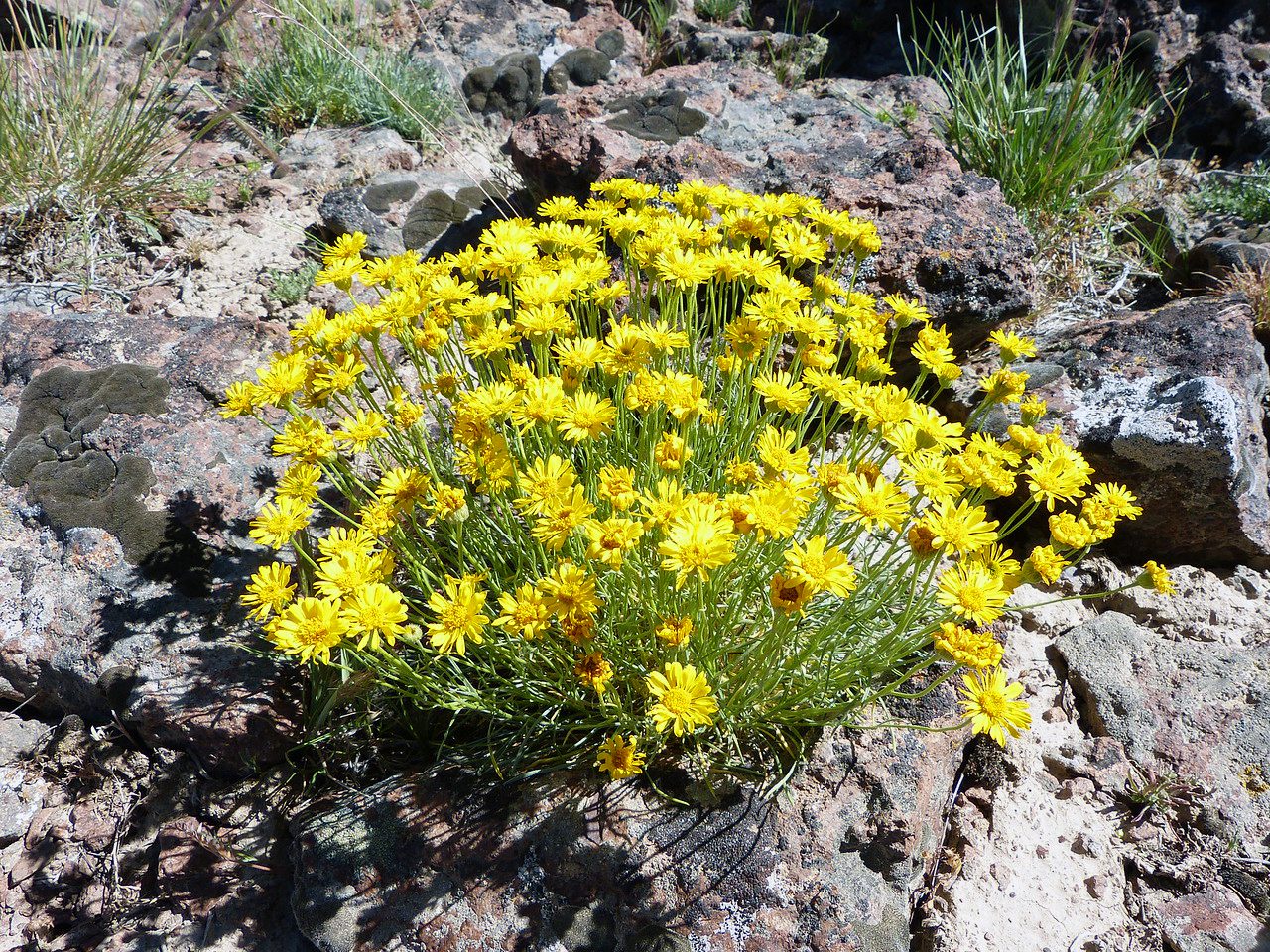 |
USDI BLM NV020, SOS. | Desert yellow fleabane | Aster family | Asteraceae | Erigeron | linearis | https://westernforbs.org/species/desert-yellow-fleabane-erigeron-linearis/ | No | No | Yes | Rare | The genus (other species) | Yes | Perennial | Forb | Clumping/caespitose, Erect/ascending | 8 | 2 | Yes | Yes | Alternate | Herbaceous perennial (dies back annually) | Simple | Tap | CA, ID, MT, NV, OR, UT, WA, WY, BC, YT | 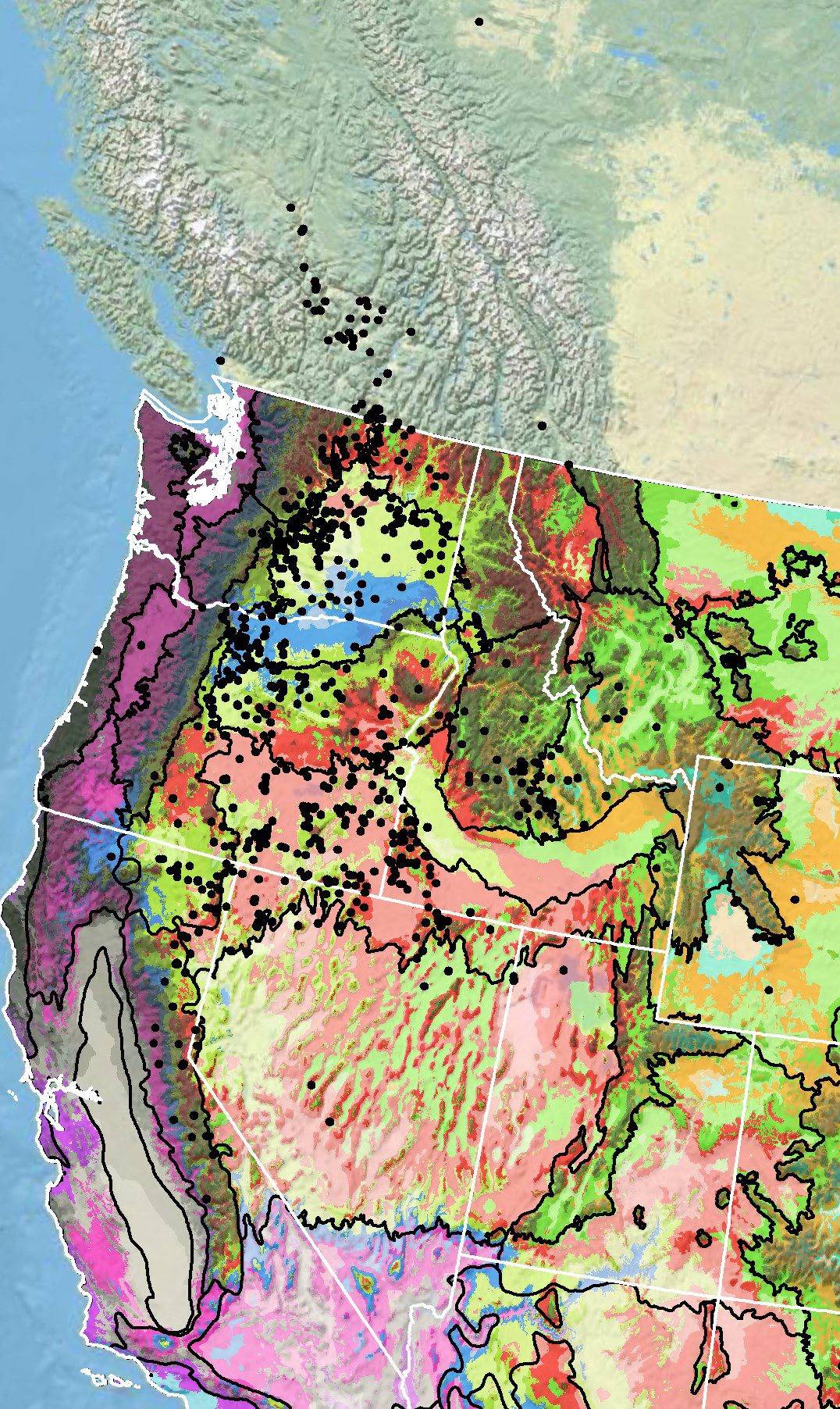 |
Distribution of desert yellow fleabane (black circles) based on geo-referenced herbarium specimens and observational data from 1885-2011. Generalized provisional seed zones (colored regions) are overlain by Omernik Level III Ecoregions (black outlines). Map prepared by M. Fisk, USDI USGS. | Semi-desert grasslands, Low sage, Sagebrush, Pinyon-Juniper, Dry forest | 6,500 | 2,300 | 16 | 6 | Clay, Silt, Sand, Loam, Coarse - Gravelly, rocky | Rocky, gravelly, Medium | Neutral | Shallow | Early, Mid | Fire, Grazing | Tolerance depends on season and site conditions. | Full sun, Partial sun | Head | 11-100 | White, Yellow | Perfect, Female (pistillate) | Biotic (animal) | Bees, Butterflies | Indeterminate | Indehiscent | Fruit | Wind | Late spring, Early summer, Summer, Late summer | No | May, June, July, August | Fruit | Dry fruit, Hard seed, Pappus expanded | Mature achene is brown. | Insects | Insects and damage visible, Low fill of seed/fruit | Indeterminate | Cut test (individual seed or seedhead), Fingernail pressure test, X-ray | Moderate (1-3 wks) | Clipping, Plucking, Swatting/beating | Clippers, Containers, Gloves | Dry thoroughly, Discard bulky vegetative material, Control for insects, Protect from rodents, Store in breathable containers, Protect from overheating | Break apart inflorescence to extract individual fruits or seeds, Remove seed appendages (i.e. pappus/ wings), Remove extra vegetative material (i.e. leaves, stems, etc.) | Yes | 0.19 | 0.02 | 0.47 | 21 | Not dormant | No | No | 93.00 | 85 | 99 | 21 | 91.00 | 79 | 98 | 21 | 89 | 69 | 97 | 21 | 1,292,289.00 | 821,739.00 | 1,829,032.00 | 21 | 1,091,264.00 | 928,546.00 | 1,419,329.00 | 18 | Orthodox | Unknown | No | 0.25-0.5 | Yes | No |